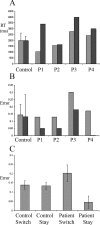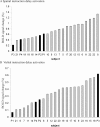Is the prefrontal cortex necessary for establishing cognitive sets?
- PMID: 18045924
- PMCID: PMC6673399
- DOI: 10.1523/JNEUROSCI.2349-07.2007
Is the prefrontal cortex necessary for establishing cognitive sets?
Abstract
There is evidence from neuroimaging that the prefrontal cortex may be involved in establishing task set activity in advance of presentation of the task itself. To find out whether it plays an essential role, we examined patients with unilateral lesions of the rostral prefrontal cortex. They were first instructed as to whether to perform a spatial or a verbal working memory task and then given spatial and verbal items after a delay of 4-12 s. The patients showed an increase in switch costs, making more errors by repeating what they had done on the previous trial. They were able to establish regional task set activity during the instruction delay, as evidenced by sustained changes in the blood oxygenation level-dependent signal in caudal frontal regions. However, in contrast to healthy controls, they were less able to maintain functional connectivity among the surviving task-related brain regions, as evidenced by reduced correlations between them during instruction delays. The results suggest that the left rostral prefrontal cortex is indeed required for establishing a cognitive set but that the essential function is to support the functional connectivity among the task-related regions.
Figures






Comment in
-
The role of rostral prefrontal cortex in establishing cognitive sets: preparation or coordination?J Neurosci. 2008 Mar 26;28(13):3259-61. doi: 10.1523/JNEUROSCI.0206-08.2008. J Neurosci. 2008. PMID: 18367592 Free PMC article. No abstract available.
References
-
- Aron AR, Monsell S, Sahakian BJ, Robbins TW. A componential analysis of task-switching deficits associated with lesions of left and right frontal cortex. Brain. 2004;127:1561–1573. - PubMed
-
- Blair J, Spreen O. Predicting premorbid IQ: a revision of the National Adult Reading Test. Clin Neuropsychologist. 1989;3:129–136.
-
- Bunge SA, Kahn I, Wallis JD, Miller EK, Wagner AD. Neural circuits subserving the retrieval and maintenance of abstract rules. J Neurophysiol. 2003;90:3419–3428. - PubMed
-
- Burgess PW, Veitch E, de Lacy Costello A, Shallice T. The cognitive and neuroanatomical correlates of multitasking. Neuropsychologia. 2000;38:848–863. - PubMed
-
- Butters N, Pandya D, Sanders K, Dye P. Behavioral deficits in monkeys after selective lesions within the middle third of sulcus principalis. J Comp Physiol Psychol. 1971;76:8–14. - PubMed
Publication types
MeSH terms
Substances
Grants and funding
LinkOut - more resources
Full Text Sources
Other Literature Sources
